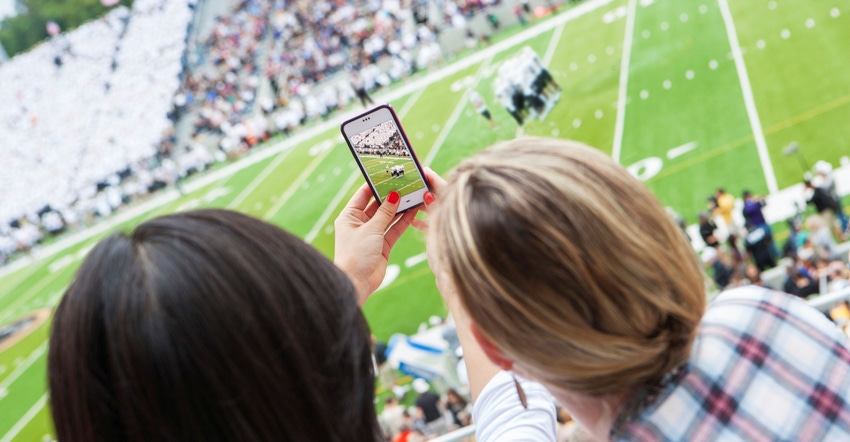FA Cup – how to score when it comes to mobile coverage
While providing mobile coverage in a large space like a stadium or arena can easily be achieved, the challenge with large events is providing enough network capacity to cope with heavy mobile use in such a short timeframe.
June 2, 2016

Telecoms.com periodically invites expert third parties to share their views on the industry’s most pressing issues. In this piece John Spindler, VP marketing and product management at Zinwave, looks at some of the challenges operators face in providing coverage in stadiums and arenas.
Football fans are increasingly relying on smartphone technology to fully immerse themselves in the experience. Mobile services such as 4G LTE enable football fans to simultaneously share photos and videos on social media, keep in touch with friends and family, and there’s even reports that they will soon be able to vote for substitutions from their smartphones during the match. But this can all present significant mobile network challenges. While providing mobile coverage in a large space like a stadium or arena can easily be achieved, the challenge with large events is providing enough network capacity to cope with heavy mobile use in such a short timeframe, while also ensuring that mobile users do not interfere with the macro network surrounding the stadium.
Event challenges and requirements
When you consider that Wembley Stadium has a capacity of 90,000, this can make it extremely difficult for mobile operators to provide uninterrupted access to mobile data services during live events, such as the FA Cup final and semi-finals. According to EE, mobile use on its network during the 2015 FA Cup semi-finals at Wembley Stadium was driven almost entirely by 4G LTE users. With a network that’s being consumed by data hungry services such as 4G LTE from multiple wireless providers, the network can often get jammed and this significantly affects voice and data services during the game. There’s also the issue of soft handover (SHO), where mobile signal bleeds from one sector or seating section to another, causing interference. As such, the mobile signal needs to be isolated, which will significantly impact the design of the stadium network infrastructure.
The lack of mobile coverage and capacity can have a significant effect on public safety communications, which is just as important – if not more important – than improving the football fan experience. For example, with the recent faux bomb scare at Old Trafford Stadium, optimal wireless coverage within the stadium would have proved effective in evacuating the stadium. Large stadiums need a strong mobile signal throughout the entire stadium for public safety, stewarding and crowd control. However, there is often poor signal or black spots that can lead to lapses in important emergency service communication systems. In order to meet safety requirements introduced by the UEFA (Union of European Football Associations), stadiums such as Wembley Stadium will need to ensure that they have an in-building wireless coverage system for all private mobile radio and critical communications networks during events such as the FA Cup final and semi-finals.
In order to select a wireless network system that is able to handle a given number of users or devices, stadium managers must firstly find out the levels of data throughput needed. In addition, they should decide whether the installation is going to be temporary or permanent, not least because some venues need a permanent high-level of service, while others will only need to deploy coverage and capacity for a particular event – such as the FA Cup – and scale down the venue deployment when the event has finished. This will give them a good indication of what architecture is suitable to their mobile network environment. For example, passive systems using heavy coaxial cabling are often suited to projects where a coverage and capacity solution will be deployed permanently and where there will be no changes required in the future (a difficult thing to predict), whereas active systems that use a hub-and-spoke architecture are easier to scale up or down when the venue requires this change.
Best practice mobile infrastructure
Stadiums are beginning to invest in Wi-Fi technology in an effort to offload some of the demand on the mobile network infrastructure. Indeed, it was recently announced that football stadiums in the UK will now benefit from free Wi-Fi. However, when you consider that almost all of the football fans during the FA Cup final were connected to 4G LTE services, the Wi-Fi approach will not suffice. Many stadiums will deploy a few antennas placed around the stadium to distribute wireless signal, but this often does not deliver enough performance for high-demand events such as the FA Cup final.
The best practice for mobile coverage and capacity is to provide focused signal (also known as a sector) on each seating section or black spot areas. What’s useful about stadiums and arenas is that they are naturally broken up into sections, so part of the groundwork is already done. Stadium managers then need to deploy dedicated base stations for the stadium system to isolate the mobile signal from the macro network. By deploying small cell architecture, such as a wideband active Distributed Antenna Systems (DAS) capable of handling multiple frequencies and operators, operators are able to extend the wireless signal from these base stations via discreet, remote antennas throughout the entire stadium, ensuring that football fans are able to take full advantage of their mobile devices – and without affecting the stadium’s existing architecture. This removes many of the traditional issues and considerations associated with delivering multiple in-building wireless services and enables high user density venues to overcome interference, soft handover and capacity management challenges, as well as better manage peaks and troughs in network traffic.
An ‘evergreen’ approach
Ultimately, small cell architecture such as a wideband active DAS is considered to be ‘evergreen,’ which means it can easily accommodate the addition of new frequencies and services. This will prove critical for stadiums with the impending rollout of 5G by 2020. By allowing multi-service, multi-operator support, and enabling wireless network providers to better manage traffic peaks and troughs, and deliver premium wireless performance on game days, football fans will have an experience they won’t forget.
 John Spindler joined Zinwave as VP marketing and product management in November 2015 and has over 30 years’ of product management and marketing experience in the wireless and telecommunications industries. His most recent role as director of product management was with TE/CommScope, and prior to this as VP marketing at ADC Telecommunications. John holds a BA degree in Psychology from UCLA and has an MBA from the Marshall School of Business at USC.
John Spindler joined Zinwave as VP marketing and product management in November 2015 and has over 30 years’ of product management and marketing experience in the wireless and telecommunications industries. His most recent role as director of product management was with TE/CommScope, and prior to this as VP marketing at ADC Telecommunications. John holds a BA degree in Psychology from UCLA and has an MBA from the Marshall School of Business at USC.
Read more about:
DiscussionAbout the Author(s)
You May Also Like








.png?width=300&auto=webp&quality=80&disable=upscale)


_1.jpg?width=300&auto=webp&quality=80&disable=upscale)


.png?width=800&auto=webp&quality=80&disable=upscale)